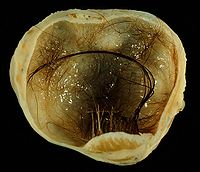
Photo from wikipedia
Purpose: To investigate the clinicopathological features of mature teratoma with malignant transformation. Methods: Retrospectively analysis of 1179 cases mature teratoma was done from August 1999 to December 2019 in Institution.… Click to show full abstract
Purpose: To investigate the clinicopathological features of mature teratoma with malignant transformation. Methods: Retrospectively analysis of 1179 cases mature teratoma was done from August 1999 to December 2019 in Institution. 14 cases of mature teratoma with malignant transformation were discussed mainly for the pathological characteristics and clinical manifestations. Results: 4 of them were less than 40 years old. All but one occurred in the ovaries, and the one was in the left anterior mediastinum which was the only male. The clinical manifestations of the patients were atypical. Imaging showed cystic solid mass. Surgery was performed. Polypoid mass, solid nodule and thickened area of cyst wall can be seen on the section of tumor. Pathological results show that there were 5 cases of squamous cell carcinoma, 3 cases of carcinoid, 2 cases of serous carcinoma and 2 cases of thyroid papillary carcinoma, 1 case of carcinosarcoma and 1 case of strumal carcinoid. Two cases of squamous cell carcinoma had pelvic and abdominal metastasis. Immunohistochemistry of case 14 showed that AE1/AE3, CD56, SYN, NSE, PSAP, CDX2 were positive in carcinoid. EMA and CK20 were positive in mucinous glands around carcinoid. Calretinin and inhibin were positive in the mesenchyme adjacent to intestinal mucinous gland. Conclusions: Teratoma with malignant transformation is a rare malignancy, although teratoma is a common germ cell tumor. And it's more common in patients over 40 years, especially those patients who were in menopause. Squamous cell carcinoma is the most common type and prone to metastasis. Strumal carcinoid was well-defined, but as an endocrine tumor, it may cause a series of digestive, respiratory or hormonal disorders. Therefore, the mature teratomas should be removed in time after detection.
Journal Title: Indian Journal of Pathology and Microbiology
Year Published: 2022
Link to full text (if available)
Share on Social Media: Sign Up to like & get
recommendations!